
Eucalyptus melliodora, commonly known as yellow box, honey box or yellow ironbark, is a species of medium-sized to occasionally tall tree that is endemic to south-eastern, continental Australia. It has rough, flaky or fibrous bark on part or all of the trunk, smooth greyish to yellowish bark above. The adult leaves are lance-shaped to egg-shaped, the flower buds are arranged in groups of seven and the fruit is more or less hemispherical.

Eucalyptus populnea, commonly known as poplar box, bimble box or bimbil box, is a species of small to medium-sized tree that is endemic to eastern Australia. It has rough, fibrous or flaky bark on the trunk and branches, egg-shaped, elliptical or more or less round leaves, flower buds arranged in groups of seven to fifteen or more, white flowers and conical, hemispherical or cup-shaped fruit.

Eucalyptus cloeziana, commonly known as Gympie messmate or dead finish, is a species of tree that is endemic to Queensland. It has rough, flaky to fibrous bark on its trunk, smooth bark above, lance-shaped to curved adult leaves that are much paler on the lower side, flower buds in groups of seven, white flowers and hemispherical fruit.

Eucalyptus lansdowneana, commonly known as the crimson mallee or the red-flowered mallee box, is a species of slender stemmed, straggly mallee that is endemic to a restricted area of South Australia. It has rough, fibrous or flaky bark at the base, smooth, grey over creamy-white bark, lance-shaped adult leaves, flower buds in groups of seven, crimson flowers and barrel-shaped fruit.
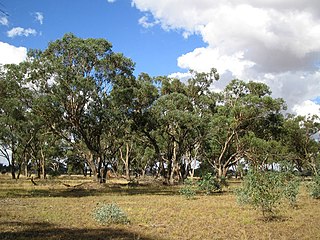
Eucalyptus microcarpa, commonly known as grey box, is a species of tree that is endemic to southeastern continental Australia. It has rough, fibrous or flaky bark on the trunk, smooth whitish bark above, lance-shaped adult leaves, flower buds in groups of between seven and eleven, white flowers and oval, cylindrical or urn-shaped fruit.

Eucalyptus pellita, commonly known as the large-fruited red mahogany, is a species of medium to tall tree that is endemic to north-eastern Queensland. It has rough, fibrous or flaky bark on the trunk and branches, lance-shaped to egg-shaped adult leaves, flower buds in groups of seven, white flowers and cup-shaped to conical fruit.

Eucalyptus porosa, commonly known as mallee box, Quorn mallee or water mallee, is a species of mallee or a tree that is endemic to southern Australia. It has rough, fibrous or flaky bark on the trunk and larger branches, smooth greyish bark above, lance-shaped adult leaves, flower buds in groups of seven, white flowers and barrel-shaped or shortened spherical fruit.
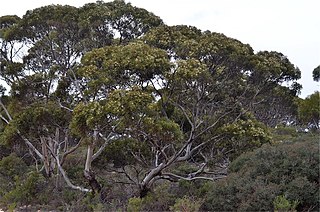
Eucalyptus gracilis, commonly known as yorrell or white mallee, is a species of mallee or small tree endemic to Australia, where it is found in south-western New South Wales], Victoria, South Australia and Western Australia. It has smooth white bark, usually with rough, fibrous or flaky bark on the lower stems, linear to narrow lance-shaped adult leaves, flower buds in group of between seven and eleven and cup-shaped, cylindrical or barrel-shaped fruit.

Eucalyptus largeana, commonly known as the Craven grey box, is a species of medium-sized to tall tree that is endemic to a restricted area of New South Wales. It has rough, fibrous or flaky bark on the trunk and larger branches, smooth greyish bark above, lance-shaped adult leaves, flower buds in groups of seven, white flowers and cup-shaped or barrel-shaped fruit.
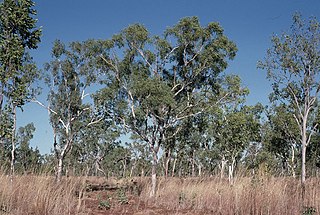
Eucalyptus tectifica, commonly known as Darwin box, or grey box, is a species of tree that is endemic to northern Australia. It has rough, fibrous or flaky bark on the trunk and branches, lance-shaped or curved adult leaves, flower buds usually in groups of seven, creamy white flowers and conical, cup-shaped or barrel-shaped fruit.
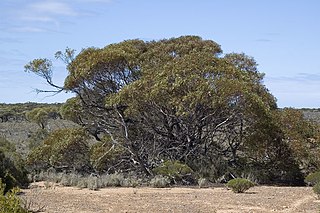
Eucalyptus yalatensis, commonly known as the Yalata mallee, is a species of mallee or a shrub that is endemic to southern Australia. It has rough, fibrous or flaky bark on the stems, smooth bark above, lance-shaped adult leaves, flower buds mostly in groups of nine, creamy white or yellowish flowers and hemispherical to shortened spherical fruit.

Corymbia aspera, commonly known as the rough-leaved ghost gum, rough leaf range gum, desert bloodwood, Brittle Range gum in Western Australia, or snappy gum in the Northern Territory is a species of tree that is endemic to northern Australia. It has smooth white bark, sometimes with a short stocking of rough bark near the base, a crown of sessile juvenile, heart-shaped or egg-shaped leaves, flower buds in groups of seven, creamy white flowers and cup-shaped, barrel-shaped or cylindrical fruit.

Corymbia latifolia, commonly known as the round-leaved bloodwood, round leaf bloodwood, wubam and other names in indigenous languages, is a species of tree that is endemic to northern Australia. It has thin, rough bark over part or all of the trunk, smooth bark above, triangular or broadly egg-shaped adult leaves, flower buds in groups of seven, creamy white flowers and urn-shaped fruit.
Eucalyptus delicata is a species of tree that is endemic to Western Australia. It has rough, fibrous to scaly bark on the trunk, smooth white to greyish bark above, linear to narrow lance-shaped adult leaves, flower buds in groups of between seven and eleven, creamy white flowers and more or less spherical to barrel-shaped fruit.
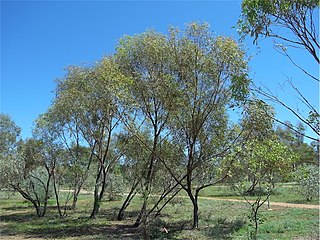
Eucalyptus normantonensis, commonly known as Normanton box, is a species of mallee, rarely a small tree, that is endemic to northern Australia. It has rough, fibrous or flaky bark on some or all of the stems, lance-shaped to curved adult leaves, flower buds in groups of between seven and eleven, white flowers and cylindrical, barrel-shaped or shortened spherical fruit.
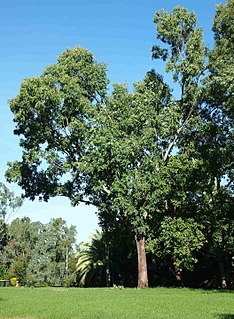
Eucalyptus raveretiana, commonly known as the black ironbox, is a species of small to medium-sized tree that is endemic to Queensland. It has rough, fibrous or flaky bark on the trunk and larger branches, smooth pale grey bark above, lance-shaped leaves, flower buds in groups of seven on a branched peduncle, white flowers and small, hemispherical fruit.

Eucalyptus socialis subsp. eucentrica, commonly known as the inland red mallee, is a subspecies of mallee that is endemic to inland Australia. It usually has rough bark on the base of the trunk, smooth bark above, lance-shaped adult leaves, flower buds in groups of between seven and eleven, pale creamy yellow flowers and barrel-shaped to urn-shaped or spherical fruit.
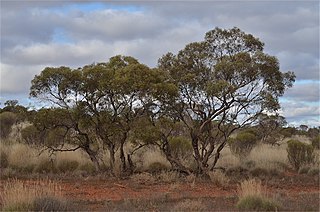
Eucalyptus socialis subsp. socialis, commonly known as the summer red mallee, is a subspecies of mallee that is endemic to inland south-eastern Australia. It usually has rough bark on the base of the trunk, smooth bark above, lance-shaped adult leaves, flower buds in groups of between seven and eleven, pale creamy white flowers and barrel-shaped to urn-shaped or spherical fruit.
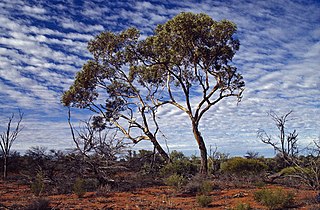
Eucalyptus socialis subsp. victoriensis, commonly known as the red mallee, is a subspecies of mallee that is endemic to southern inland Australia. It usually has rough bark on the base of the trunk, smooth bark above, lance-shaped adult leaves, flower buds in groups of between seven and eleven, pale creamy yellow flowers and barrel-shaped to urn-shaped or spherical fruit.
Eucalyptus socialis subsp. viridans, commonly known as the green-leaved red mallee, is a subspecies of mallee that is endemic to south-eastern Australia. It usually has rough bark on the base of the trunk, smooth bark above, lance-shaped adult leaves, flower buds in groups of between seven and eleven, pale creamy yellow flowers and barrel-shaped to urn-shaped or spherical fruit.


















